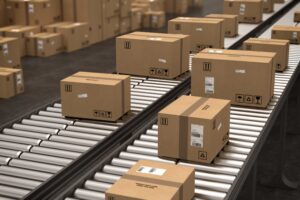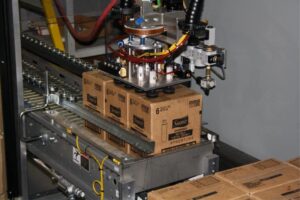Have you ever wondered how products in a warehouse or manufacturing facility are neatly stacked onto pallets, ready for shipment? The answer lies in a machine called a palletizer. Palletizers are essential in organizing products efficiently for transport and storage, saving both time and labor. Today, we’re focusing on a specific type of palletizer, the high-speed in-line palletizer and exploring what makes it unique and indispensable in modern industries.
Whether you’re a business owner aiming to improve your operations or just curious about the technologies behind large-scale product handling, this blog will provide a clear and engaging overview of high-speed in-line palletizers.
What is a High-Speed In-Line Palletizer?
A high-speed in-line palletizer is a machine designed to quickly stack products onto a pallet in a way that’s ready for shipment. These machines can handle large volumes of products in a short amount of time, ensuring that items are neatly and efficiently organized for transportation.
Think of it as an expert “stacker” in a warehouse. Instead of relying on manual labor to lift and arrange products, this machine does it with precision, consistency, and, most importantly, speed. The term “in-line” means that the palletizer is integrated into a conveyor line system, making the entire stacking process continuous and seamless.
Why Use a High-Speed In-Line Palletizer?
Now, you might be wondering, why use such a specialized machine? Here are some reasons why high-speed in-line palletizers have become essential in many industries:
- Efficiency: With their ability to stack products rapidly, high-speed in-line palletizers boost productivity. They are significantly faster than manual labor, which means that businesses can get their products out the door faster.
- Cost Savings: While the initial investment in a palletizer may seem steep, the long-term cost savings are substantial. Companies can save on labor costs and reduce the risk of injuries that often come with repetitive lifting.
- Precision and Consistency: A palletizer works the same way, every time. It ensures that each pallet is stacked uniformly, reducing the chance of products being damaged during transit.
- Space Management: A well-stacked pallet saves space during storage and transportation, which means lower costs for storage and shipping.
How Does a High-Speed In-Line Palletizer Work?
It might sound complex, but the working principle of a high-speed in-line palletizer is quite straightforward. Here’s a step-by-step guide on how it typically operates:
- Product Alignment: Products are brought to the palletizer via a conveyor belt. They are aligned and arranged in a specific orientation so that the palletizer can stack them effectively.
- Layer Formation: Once the products reach the palletizer, they are arranged into layers. This is key for creating a stable stack that won’t topple during transport.
- Layer Transfer: The complete layer is then transferred onto the pallet. The in-line palletizer ensures that the products are placed accurately, forming a neat and balanced stack.
- Repetition: This process repeats for as many layers as needed. Once a pallet is fully stacked, it’s moved away (often via an automated conveyor) to make room for the next one.
This entire process is automated, making it incredibly efficient. The “high-speed” aspect means that it can handle a large number of products per minute, perfect for industries where high output is crucial.
Where are High-Speed In-Line Palletizers Used?
You’ll find these machines in a wide variety of industries, including:
- Food and Beverage: Think of bottled drinks, packaged foods, or canned goods. These need to be stacked efficiently to keep up with consumer demand.
- Pharmaceuticals: Pharmaceuticals often need to be stacked and transported with extreme care to ensure product safety.
- Consumer Goods: Anything from cleaning supplies to electronics might go through a high-speed palletizer to be prepared for shipment.
Benefits of High-Speed In-Line Palletizers Over Manual Palletizing
Manual palletizing used to be the standard, and some companies still rely on it. However, high-speed in-line palletizers have clear advantages over manual methods:
- Speed: A human can only stack so fast, and fatigue is a real issue. A machine can keep up a steady pace all day, every day.
- Reduced Risk of Injury: Repetitive lifting can lead to injuries for human workers. Palletizers eliminate that risk, making the workplace safer.
- Consistency: Machines don’t get distracted or tired, so they perform the task the same way every time, reducing the risk of error.
Factors to Consider When Choosing a High-Speed In-Line Palletizer
If you’re considering investing in a high-speed in-line palletizer, here are a few factors to keep in mind:
- Product Type: What kind of products will you be stacking? Make sure the palletizer can handle the size, shape, and weight of your items.
- Speed Requirements: How many units do you need to palletize per hour? Different models have different throughput capabilities, so choose one that matches your production volume.
- Space Availability: Palletizers come in different sizes, so it’s important to ensure you have enough floor space for the machine and any associated equipment.
- Budget: While palletizers can be a significant investment, the cost savings in labor and efficiency can make them worth it. Look at your long-term goals when assessing your budget.
Tips for Maintaining Your High-Speed In-Line Palletizer
To get the most out of your palletizer, regular maintenance is key. Here are some tips to keep it running smoothly:
- Regular Inspections: Schedule routine inspections to identify and address any issues before they lead to downtime.
- Training for Operators: Ensure that operators are properly trained to use the machine, as incorrect usage can lead to damage or inefficient performance.
- Lubrication and Cleaning: Keep moving parts lubricated and clean to ensure smooth operation. Dust and debris can affect performance over time.
Is a High-Speed In-Line Palletizer Right for You?
Deciding whether a high-speed in-line palletizer is right for your business depends on a few key factors:
- Production Volume: If you’re dealing with a high production volume that requires fast and consistent palletizing, an in-line palletizer could be a game-changer.
- Labor Costs: If labor costs are high or if you’re struggling to find enough workers for repetitive tasks, a palletizer can help bridge that gap.
- Space and Budget: You’ll need to consider your available space and budget, as palletizers are a big investment.
Automatic Packaging System Manufacturers
If you are looking for a comprehensive packaging solution, be sure to explore AFA Systems. We specialize in providing a wide range of automated packaging systems designed to streamline your operations and improve efficiency.
Some of the machinery we provide for your packaging needs includes:
- Cartoning Machine: Used for efficiently packing products into cartons, perfect for retail-ready packaging.
- Case Packer Machine: A versatile machine that packs products into cases, ready for storage or shipment.
- Palletizer Machine: Ideal for stacking products onto pallets quickly and efficiently.
- Used Packaging Equipment: A more budget-friendly option for businesses looking to save on equipment costs.
- Case Erector: Automatically forms cases from flat boxes, saving time and labor.
- Packaging Robots: Robotics solutions for high-speed and precise packaging tasks, perfect for modern automation needs.
At AFA Systems, we are dedicated to delivering innovative and efficient packaging solutions, ensuring you stay ahead in today’s competitive market.
Conclusion
High-speed in-line palletizers are transforming how companies handle their end-of-line operations. By automating the stacking process, they save time, reduce labor costs, and ensure a higher level of precision and safety. If your business is growing and you’re looking for ways to boost efficiency, a high-speed in-line palletizer might just be the solution you need.





